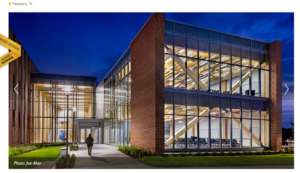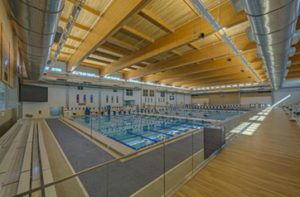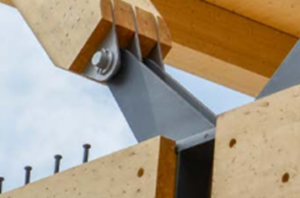
Maurice Mullaly – Sustainable Infrastructure Committee
Mass Timber construction has a longstanding presence, yet it has often remained somewhat enigmatic. During my civil structural engineering studies, we received lectures on Mass Timber and its potential applications, but it was consistently presented as an unconventional choice. Nowadays, if you explore Houston diligently, you’ll notice a rising number of buildings where Mass Timber construction has been embraced.
Mass Timber construction has a history dating back to around 1860 but has frequently appeared as a novelty when encountered in sizable structures. The use of properly sourced Mass Timber greatly reduces the carbon footprint for a building’s construction. Carbon is sequestered in the timber rather than generated during the manufacture of traditional building products.
Over the last decade, Mass Timber buildings have gained significant acceptance as a viable structural system throughout the United States. In the Houston area alone, approximately 57 buildings have incorporated the concept into their structures, with an additional 84 either in the design phase or under consideration.

Anderson-Ball Building at San Jacinto College.
In December of 2021, the WHA Sustainable Infrastructure Committee had the opportunity to visit the nearly completed Anderson-Ball Classroom Building at San Jacinto College. This visit allowed us to witness firsthand the structural and artistic possibilities offered by Mass Timber construction. The 122,000 square foot three-story building is predominantly constructed from timber and stands as one of the first of its size in the Greater Houston area. Subsequently, the building was recognized as a winner of the 2023 Wood Design Awards.
Mass Timber construction has proven exceptionally effective in cases where expansive, open spans are required. Having spent a considerable amount of time at high school swimming pools in recent years, I’ve often observed that the roof structures frequently feature large, free-spanning timber beams and wooden ceiling panels. One notable example is the CyFair ISD Natatorium in Northwest Houston, boasting a 140-foot clear-span Glulam beam roof structure supported by concrete columns. Despite the substantial beam depth of 8 feet, their size is hardly noticeable amidst the expansive Natatorium space.

CyFair ISD Natatorium
H-E-B and the Bridgeland Community represent some of the latest proponents of this technology, with the announcement that the new H-E-B within the community will be a 100,000 square foot Mass Timber building, accompanied by an additional 49,000 square foot Mass Timber office building nearby. Both are slated for opening in 2024. Howard Hughes Corporation, in an article in the Houston Chronicle, estimates that the use of mass timber will cut the project’s greenhouse gas emissions by about 20% when compared to traditional steel and concrete construction.
Mass Timber structures offer an elegant and sustainable alternative to conventional building systems, where the structural elements enhance the building’s aesthetic appeal. Unfortunately, they remain somewhat unfamiliar to many general contractors. In conversations within the industry, I have observed an initial apprehension when encountering this system for the first time. However, this unease tends to dissipate once professionals witness the installation process. Typically, a specialized crew is employed for the initial structure erection, but there is a growing willingness to utilize standard steel erection crews as they become more accustomed to the process.
 Another notable consideration is that since the structure is often left exposed to enhance the building’s appearance, precautions must be taken to prevent dents or damage to the beams and columns during installation, as such repairs can be labor-intensive.
Another notable consideration is that since the structure is often left exposed to enhance the building’s appearance, precautions must be taken to prevent dents or damage to the beams and columns during installation, as such repairs can be labor-intensive.
Overall, Mass Timber buildings offer an attractive alternative structural system, gaining increasing acceptance as local examples become more accessible and a better understanding of the system’s advantages and disadvantages prevails. In the industry, there’s an adage that being “First to be Second” is wise, and Mass Timber structures are currently at a point where experimenting with them could prove worthwhile.
